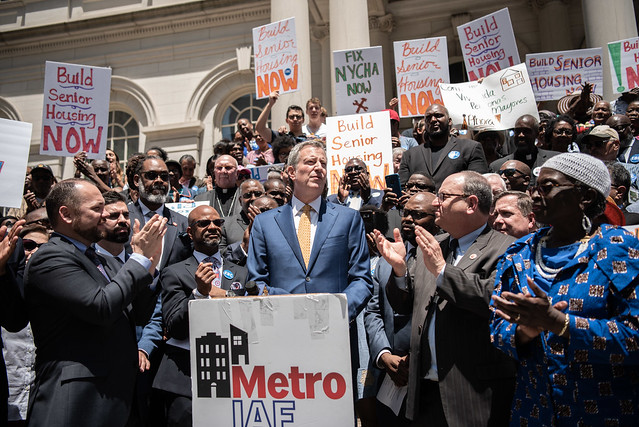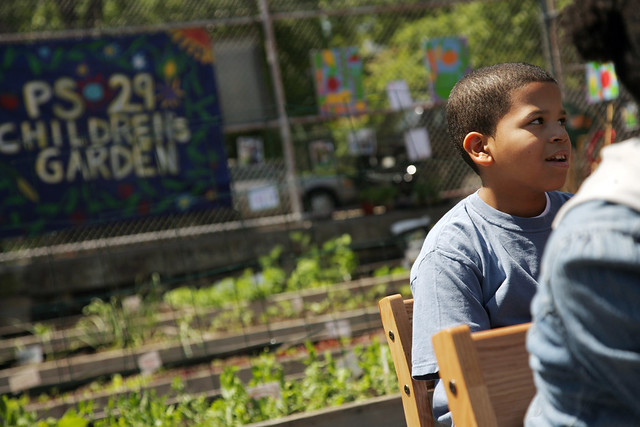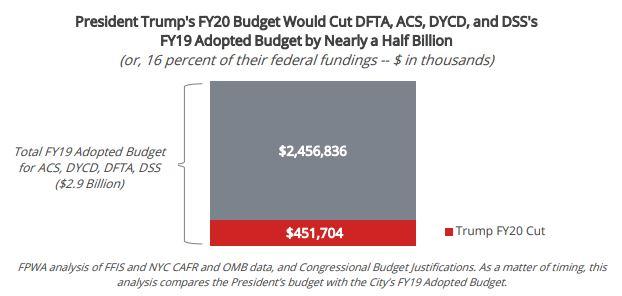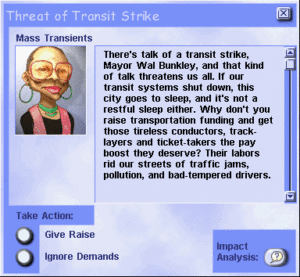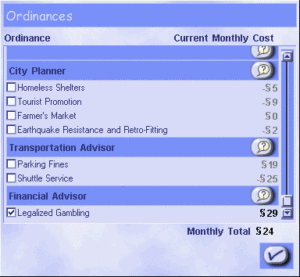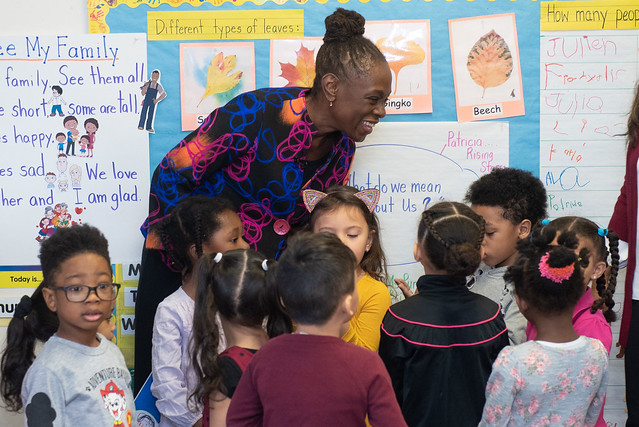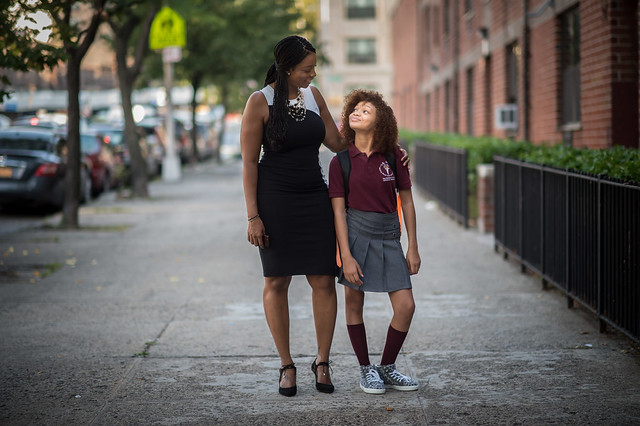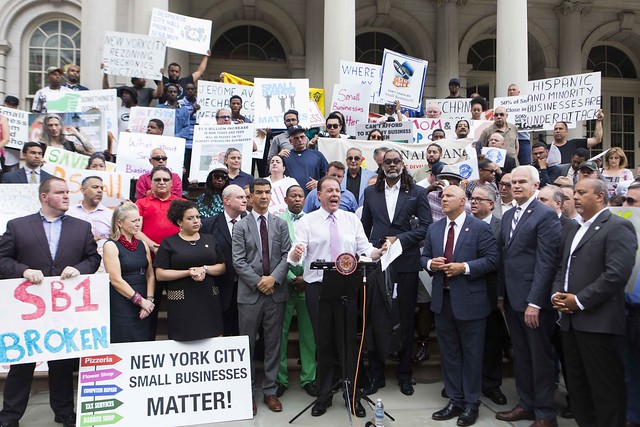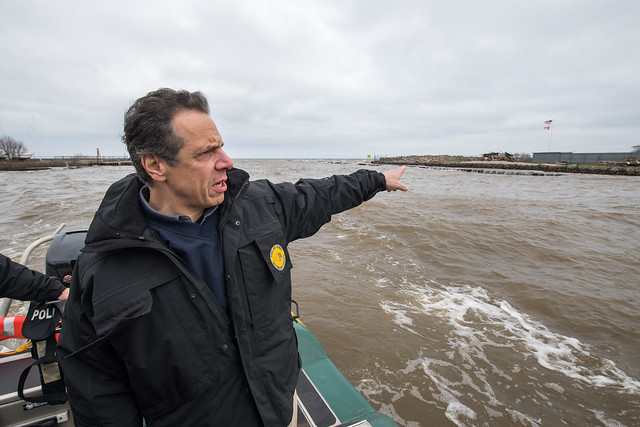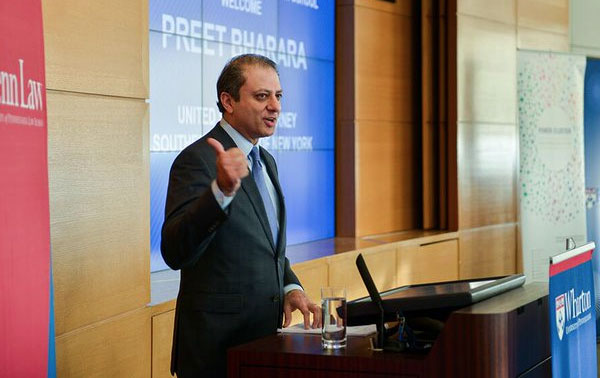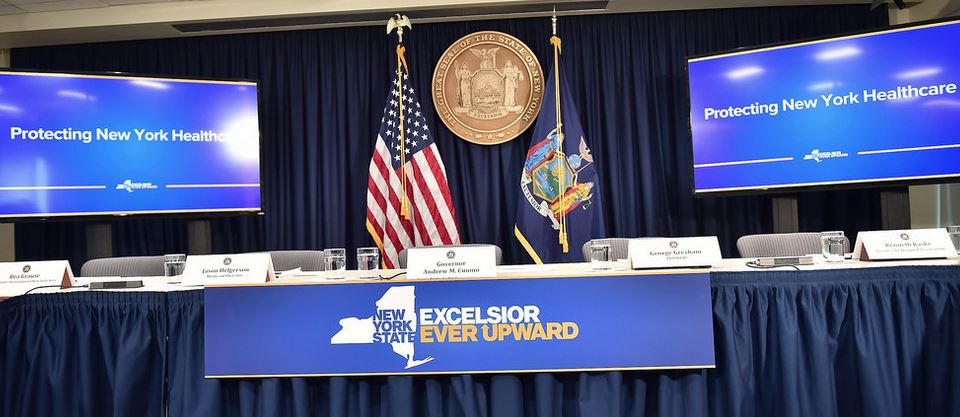
(photo: Kevin P. Coughlin/Office of Governor Andrew M. Cuomo)
New York State had achieved the highest percentage of residents with health insurance coverage of the four most populous states in the country by 2017, according to the Kaiser Family Foundation, one of the nation's leading health research organizations.
Ninety-four percent of New York's residents had health insurance coverage that year; California was second, with 93%. Both of these states accepted the Obamacare Medicaid Expansion, and both had 26% of their populations served by Medicaid in 2017. Texas and Florida, the other two of the four most populous states, both rejected the Medicaid expansion and had 83% insured and 87% insured, respectively. The United States as a whole had achieved 91% of its population covered by health insurance by 2017.

A report by State Comptroller Thomas DiNapoli actually pegged New York's health insurance coverage rate even higher in January 2018, at 95%, citing Center for Disease Control data. Either number for New York, 94 or 95%, reflects a solid record of attainment of social well-being in the state; not perfect, by any means, but very good.
So how did New York get there?
This article looks at how New York's policies achieved these positive results, as well as prospects for improvement.
First, however, it's useful to take a look at the immediate pre-Obamacare environment for the nation and these most-populous states, as well as how the states and the nation were faring in 1998-2000 as the Clinton administration came to a close in a period of substantial economic growth.
The following tables look at health coverage in the United States and the four big states in 2008 and 2010, as the Great Recession was beginning and ending.

In 2008, 15% of the nation's residents did not have health insurance and 13% were in the Medicaid program. In New York, 12% of residents were uninsured and 13% of residents were on Medicaid. By 2010, after the Great Recession, the uninsured had risen to 16% of the country, and 17% on Medicaid. In New York, uninsured was still 12%, but 22% were on Medicaid.
A 2001 U.S. Census Bureau report showed uninsured rates for 1998-2000. As the American economy continued to expand at the end of the Bill Clinton years, health insurance coverage reached 14% uninsured by 2000.
New York's situation was worse than the nation in 1998-2000, with 15.7% of its residents uninsured in 1998, and 15.1% uninsured in 2000.
In 2000, California had 17.9% uninsured, Texas 23.2%, and Florida, 17.2%. New York, at 15% uninsured, had a higher percentage of its residents with health insurance of the four largest states, but all four had higher levels of uninsured than the nation.
What happened? First: the Defeat of Block Grants for Medicaid
After the Republican Party won the House and Senate in 1994, the new Republican majorities passed legislation to limit Medicaid spending by providing a capped lump-sum amount of money for Medicaid to every state in the country, effectively eliminating the program as an entitlement. This lump sum was called a Block Grant.
Initially, welfare and other spending for poor people would also be given to states as a block grant. President Clinton vetoed this entire package in December 1995. New York Governor George Pataki made similar proposals, which were rejected by the Democratic-controlled Assembly. Ultimately, Clinton was able to force Congress to separate Medicaid from welfare, with welfare becoming the "Temporary Assistance to Needy Families" block grant (in New York), while Medicaid health care was preserved as an entitlement for the poor.
Enter Child Health Plus and Family Health Plus
In 1997, President Clinton proposed and Congress approved a program to expand health insurance coverage for children up to age 19. In 1999, the New York State Legislature passed legislation, which Governor Pataki signed, authorizing New York to apply for approval from the federal government for a program to be named Family Health Plus, enrolling the parents of children in Child Health Plus (CHP), up to 150% of the poverty level, in the Medicaid program.
Childless adults earning up to 100% of the poverty level would also be permitted to enroll. CHP in New York had enrolled over 500,000 children by 2001, and the federal government approved the Family Health Plus waiver. Implementation was planned for the fall of 2001.
A Health Emergency is Declared in New York After 9/11
The horrific impacts of the September 11, 2001 attacks on the United States and New York are known as part of American history.
But there was a side story about health care in New York that is less well-known. The New York State government's Medicaid computers were in the World Trade Center and were destroyed in the attacks.
These computers contained the information on the eligibility of those enrolled in the Medicaid program. Medicaid was very bureaucratic; recipients had to submit proof of their continued eligibility every year in a recertification process. After the Medicaid computers were destroyed, Governor Pataki announced on September 19, 2001 that New York had received an emergency waiver of the recertification requirements for Medicaid for New York City only through January 31, 2002.
A program known as Disaster Relief Medicaid was implemented that allowed persons to merely fill out a one-page document and attest they were eligible for Medicaid -- 350,000 people enrolled by the deadline.
New York's Family Health Plus program began its implementation shortly after 9/11 as well, allowing adults with children and earning up to 150% of the poverty line to enroll in Medicaid. A national recession was underway at the time of the 9/11 attack -- exacerbated in New York, of course, by the devastation in downtown Manhattan.
New York State lost nearly 200,000 jobs between August 2001 and August 2003, heavily concentrated in New York City. The confluence of all these events resulted in a major expansion of the Medicaid program in New York State; enrollment rose from 2.7 million in 2000 to 3.9 million in 2004.
New York State also began subsidizing small-group private health insurance through a program known as Healthy New York, where subsidized enrollment reached 145,000.
New York 2005-2013: The Great Recession, Medicaid Reform, Preparing for Obamacare
The New York State economy recovered from the recession and the Trade Center attack from 2003-2008, and the Medicaid rolls remained fairly stable, reaching 4.1 million in 2008. The Great Recession began in 2008, with the nation losing 8.5 million jobs from 2008 through February 2010.
New York lost more than 300,000 jobs and about 1 million residents were added to the Medicaid program, bringing Medicaid enrollment to about 5 million before Obamacare, enacted in 2010. This major new program, intended to provide health insurance to 30 million or more additional Americans, had a lead time of several years for the states to develop the ability to implement it.
The recession caused staggering New York State budget deficits. Struggling to cope, both Governors Paterson and Cuomo undertook intensive cost-containment efforts in the Medicaid program while maintaining and even enhancing eligibility. Participation in managed care became standard for Medicaid recipients, even the disabled. New York enacted some utilization limits and tightened reimbursement rates for providers. But the State still took steps to streamline and simplify Medicaid, such as allowing 12-month eligibility periods, eliminating the asset test and fingerprinting, affirming the experience of Disaster Relief Medicaid.
New York also accepted grants from the federal government to get Obamacare up and running by the beginning of 2014. New York integrated its Medicaid program with the new Obamacare health exchanges, in what became known as New York State of Health. Family Health Plus was folded into Obamacare. State government planned for the state to centralize Medicaid administration and take over enrollment processing for persons newly applying for Medicaid as well as the private health insurance plans offered on the exchanges.
Obamacare: 94-95% of New Yorkers Now Insured
By 2013 New York had reached 89% of its population covered by health insurance, and launched Obamacare in 2014. Another 1.2 million New Yorkers were enrolled in the Medicaid program and 250,000 in the new private plans during the Obamacare rollout.
New York adopted a screening policy for applications through the Exchange to enroll residents in Medicaid if they were determined to be eligible, resulting in New York's small private plan enrollments. After all, the federal government was covering 100% of the new costs up to 2019.
New York also received approval in 2015 from the federal government to add residents not eligible for Medicaid into a new insurance program called New York Essential Care, which now covers nearly 750,000, including adults from the Family Health Plus program whose eligibility for Obamacare Medicaid had not been preserved in the switchover. Comptroller DiNapoli's report cited New York as one of only two states in the country to create such a Plan (which is being paid 93% by the federal government). Adding this program to Medicaid enrollment (now 6 million plus) brings 7 million New Yorkers into non-Medicare public plans. 95% of New Yorkers now have health insurance.
The state government recently took important steps to codify elements of the Obamacare rollout into state law through the new state budget, protections toward stability in case there is significant undercutting of the health care law via the Supreme Court or other federal action.
Three Legislators
Three members of the New York State Legislature deserve special mention for extraordinary leadership in the state’s achievements in health insurance. One is Assemblymember Dick Gottfried of Manhattan, the senior member of the Legislature who has chaired the Assembly Health Committee since 1987. Second is State Senator Kemp Hannon, a Republican from Nassau County, who chaired the State Senate Health Committee and supported the Medicaid expansions and shepherded them through the Republican-controlled State Senate. He was defeated in 2018. And third, James Tallon, who served in the State Assembly from 1975-1993, as Majority Leader and Gottfried’s predecessor as chair of the Health Committee. He became President of the United Hospital Fund in 1993 and became the state’s intellectual leader in health care.
What’s Next?
New York still has 1 million to 1.2 million residents without health insurance. The Kaiser Foundation reports that 8% of New York non-elderly adults age 19-64 still do not have health insurance.
Recently the de Blasio administration announced a plan to enroll several hundred thousand more New York City residents without health insurance into a New York City insurance plan based on its network of municipal hospitals and clinics, which have their own Medicaid Managed Care Plan (the city is also attempting to enroll undocumented immigrants, who can’t be insured, into health care plans where they are assigned primary care doctors).
The city’s efforts are a good idea and the New York State government should help the city by paying for outreach and facilitated enrollment.
New York could still build on the substantial increases in health insurance outside New York City as well, and continue efforts to provide small group coverage through its Exchange. The top five states for insurance coverage in the nation have reached 96-97% of their residents insured.
And Single-Payer? Don’t Forget Donald Trump
The New York State Assembly has passed a single-payer health plan, called the New York Health Trust, several times, as recently as 2018,; it is now bill A. 5248 in the current legislative session.
Moving forward with such a plan still has innumerable hurdles, one of which involves folding the Medicare program into a comprehensive New York health insurance plan, necessitating federal government approval under the Trump administration, which is not likely. Single-payer must also pass the State Senate and be supported by Governor Cuomo.
Going into the 2020 presidential election, even if Donald Trump is defeated and the Democrats take back the United States Senate it's not certain there will be a national consensus on single-payer or Medicare-for-All. Incremental progress might still be the choice. It is clear New York State has made great progress and still has the capacity to do better, something New Yorkers should be proud of.
***
Jim Brennan was a member of the New York State Assembly for 32 years, where he chaired four committees. On Twitter @JimBrennanNY.
***
Have an op-ed idea or submission for Gotham Gazette? Email This email address is being protected from spambots. You need JavaScript enabled to view it.
